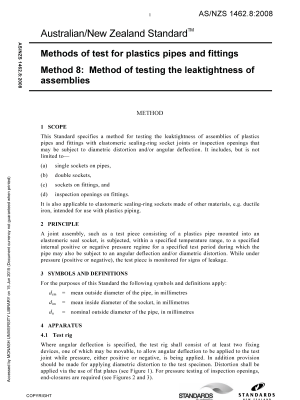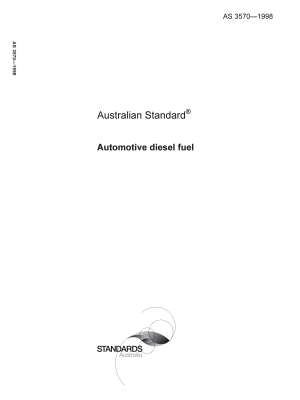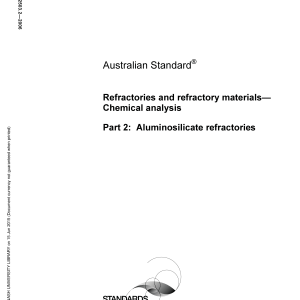🔍

Purchase the full subscription package now and enjoy a 40% discount, along with free updates for future editions.
AS 2503.2-2006
$125.14
Refractories and refractory materials — Chemical analysis, Part 2: Aluminosilicate refractories
Sets out methods for the sampling, preparation of sample and analysis of aluminosilicate refractories and refractory materials.
Table of contents
Header
About this publication
Preface
1 Scope and general
1.1 Scope
1.2 Referenced documents
1.3 Definitions
1.4 Repeatability
1.5 Principle
1.5.1 Loss on ignition
1.5.2 Determination of silicon, phosphorus, aluminium, iron, titanium and manganese oxides (see Section 4)
1.5.3 Determination of calcium, magnesium, sodium, potassium and lithium oxides (see Section 5)
1.6 Safety
1.7 Test report
2 Sampling and sample preparation
2.1 Scope of section
2.2 Gross sampling
2.3 Preparation of sample
2.3.1 Crushing
2.3.1.1 Bricks
2.3.1.2 Ground materials
2.3.2 Preliminary treatment
2.3.3 Preparation of sample for analysis
2.3.3.1 Portion A—to be used for the main analysis
2.3.3.2 Portion B—to be used where iron determination is required
3 Determination of loss on ignition
3.1 Scope of section
3.2 Apparatus
3.2.1 Balance
3.2.2 Muffle furnace
3.2.3 Drying oven
3.3 Procedure
4 Determination of silicon, phosphorus, aluminium, iron(III), titanium(IV) and manganese(II) oxides
4.1 Scope of section
4.2 Reagents
4.2.1 General
4.2.2 Solid reagents
4.2.2.1 Boric acid
4.2.2.2 Potassium carbonate/sodium carbonate, anhydrous, mixed in equimolecular proportions.
4.2.2.3 Potassium pyrosulfate
4.2.2.4 Sodium peroxide
4.2.3 Solutions
4.2.3.1 Ammonia solution (ρ20 0.88 g/mL)
4.2.3.2 Ammonia solution (500 mL/L)
4.2.3.3 Ammonium acetate buffer solution
4.2.3.4 Ammonium acetate buffer solution (400 g/L)
4.2.3.5 Ammonium acetate buffer solution (100 g/L)
4.2.3.6 Ammonium metavanadate solution (2.5 g/L)
4.2.3.7 Ammonium molybdate solution (100 g/L)
4.2.3.8 Ammonium persulfate solution (100 g/L)
4.2.3.9 Base solution
4.2.3.10 Chloroform
4.2.3.11 Cupferron solution (60 g/L)
4.2.3.12 Ethanol or industrial alcohol (950 mL/L)
4.2.3.13 Hydrochloric acid (ρ20 1.18 g/mL)
4.2.3.14 Hydrochloric acid (500 mL/L)
4.2.3.15 Hydrochloric acid (200 mL/L)
4.2.3.16 Hydrochloric acid (50 mL/L)
4.2.3.17 Hydrofluoric acid (p20 1.13 kg/m3)
4.2.3.18 Hydrogen peroxide solution (60 g/L)
4.2.3.19 Hydroxylammonium chloride solution (500 g/L)
4.2.3.20 Hydroxylammonium chloride solution (100 g/L)
4.2.3.21 8-Hydroxyquinoline solution (50 g/L)
4.2.3.22 Nitric acid (ρ20 1.42 g/mL)
4.2.3.23 Nitric acid (330 mL/L)
4.2.3.24 Perchloric acid (ρ20 1.54 g/mL)
4.2.3.25 1,10-Phenanthroline solution (10 g/L)
4.2.3.26 Phosphoric acid (400 mL/L)
4.2.3.27 Sodium nitrite solution (50 g/L)
4.2.3.28 Sorbitol solution (80 g/L)
4.2.3.29 Sulfuric acid (500 mL/L)
4.2.3.30 Tin(II) chloride solution (10 g/L)
4.2.4 Standard solutions
4.2.4.1 Aluminium solution (1 mL ≡ 1.0 mg of Al2O3)
4.2.4.2 EDTA solution (0.05 mol/L approx.)
4.2.4.3 Iron(III) solution (1 mL ≡ 1.0 mg of Fe2O3)
4.2.4.4 Iron(III) solution (1 mL ≡ 0.01 mg of Fe2O3)
4.2.4.5 Manganese(II) solution (1 mL ≡ 1.0 mg of MnO)
4.2.4.6 Manganese(II) solution (1 mL ≡ 0.01 mg of MnO)
4.2.4.7 Phosphorus solution (1 mL ≡ 1.0 mg of P2O5)
4.2.4.8 Phosphorus solution (1 mL ≡ 0.1 mg of P2O5)
4.2.4.9 Silicon solution (1 mL ≡ 0.5 mg SiO2)
4.2.4.10 Silicon solution (1 mL ≡ 0.04 mg SiO2)
4.2.4.11 Titanium(IV) solution (1 mL ≡ 0.8 mg TiO2)
4.2.4.12 Titanium(IV) solution (1 mL ≡ 0.08 mg TiO2)
4.2.4.13 Zinc solution (0.05 mol/L)
4.2.5 Indicators
4.2.5.1 Dithizone solution (0.25 g/L)
4.2.5.2 Methyl orange solution (0.5 g/L)
4.2.5.3 Methyl red solution (1 g/L)
4.2.5.4 Phenolphthalein solution (10 g/L)
4.3 Apparatus
4.3.1 Balance
4.3.2 Furnace
4.3.3 Drying oven
4.3.4 Muffle furnace
4.3.5 Steam bath
4.3.6 Glassware
4.3.7 Platinum dish
4.3.8 UV-visible spectrometer
4.4 Procedure
4.4.1 Blank determination
4.4.2 Decomposition methods for the preparation of the solution sample
4.4.2.1 Introduction
4.4.2.2 Carbonate fusion
4.4.2.3 Carbonate/boric acid fusion
4.4.2.4 Peroxide decomposition
4.4.3 Determination of silicon dioxide
4.4.3.1 Gravimetric determination of insoluble silicon dioxide
4.4.3.2 Spectrometric determination of soluble silicon dioxide
4.4.3.3 Calculation of total silicon dioxide content
4.4.4 Determination of phosphorus pentoxide
4.4.5 Determination of aluminium oxide
4.4.5.1 Introduction
4.4.5.2 Removal of iron(III) and titanium(IV) dioxide
4.4.5.3 Gravimetric determination
4.4.5.4 Volumetric determination
4.4.6 Determination of iron(III) oxide
4.4.7 Determination of titanium(IV) dioxide
4.4.8 Determination of manganese(II) oxide
5 Determination of calcium, magnesium, sodium, potassium and lithium oxides
5.1 Scope of section
5.2 Reagents
5.2.1 General
5.2.2 Solutions
5.2.2.1 Ammonia solution
5.2.2.2 Hydrochloric acid
5.2.2.3 Hydrofluoric acid
5.2.2.4 Nitric acid
5.2.2.5 Perchloric acid
5.2.2.6 Potassium hydroxide solution (250 g/L)
5.2.2.7 Triethanolamine solution (500 mL/L)
5.2.3 Standard solutions
5.2.3.1 Calcium solution (1 mL ≡ 1.0 mg of CaO)
5.2.3.2 Magnesium solution (1 mL ≡ 1.0 mg of MgO)
5.2.3.3 EDTA solution (0.01 mol/L approximately)
5.2.4 Indicators
5.2.4.1 Methyl thymol blue complexone
5.2.4.2 Screened calcein
5.3 Apparatus
5.3.1 Balance
5.3.2 Drying oven
5.3.3 Steam bath
5.3.4 Glassware
5.3.5 Platinum dish
5.3.6 Flame photometer
5.4 Procedure
5.4.1 Preliminary procedures
5.4.1.1 Blank determination
5.4.1.2 Solution of the sample
5.4.2 Oxide determinations
5.4.2.1 Calcium oxide
5.4.2.2 Magnesium oxide
5.4.2.3 Sodium, potassium and lithium oxides
Appendix A
A1 Ignition loss, SiO2, P2O5, Al2O3, Fe2O3, TiO2, MnO
A2 CaO, MgO, Na2O, K2O, Li2O
Cited references in this standard
Please select a variation to view its description.
| Published | 30/06/2006 |
|---|---|
| Pages | 28 |
Please select a variation to view its pdf.





